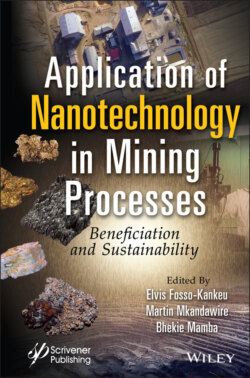Читать книгу Application of Nanotechnology in Mining Processes - Группа авторов - Страница 22
1.4.2.2 Reactor 2 – Mixing Tank
ОглавлениеImmediately after filtration, the acidic effluent will be pumped into the mixing tank for further treatment. At this stage, sulfate ions that are considered the main impurities will be removed to prevent them from reacting with metal ions in the effluent as such, lowering the grade of metals to be recovered. To circumvent the effects of sulphate ions, lime water (calcium hydroxides) from a different tank is pumped simultaneously with PAMAM-COOH@MNPs into the mixing tank. The pH is controlled using the lime water until it reaches the neutral point while stirring the reaction mixture at 400 rpm for 24 hours. The process of controlling the pH using calcium hydroxides is known as stage precipitation, which prevents the sulphate ions from complexing with the REEs within the acidic condition. The introduction of Ca2+ ions will react with the sulfate ligands as the rate of bonding interaction between these two ions is faster than the REE ions in solution due to the high reactivity of Ca2+ ions (Eq. 1.1). Eventually, the proportion of REE ions in the solution will subsequently increase, and its recovery will be enhanced [73]. The introduction of PAMAM-COOH@ MNPs at the initial stage under an acidic condition causes the protonation of the carboxylic functional group on the surfaces of dendrimer producing anions in solution, and since lanthanides are hard Lewis acids and prefer binding to hard donor atoms, such as oxygen [74], will eventually bind with the REE ions on the surfaces of PAMAM-COOH@MNPs via electrostatic force of attraction (Eq. 1.2).
(1.1)
(1.2)
